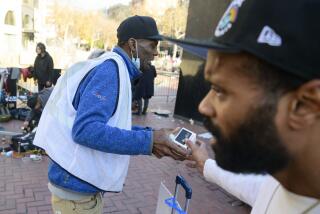Drug Therapy’s Value Stressed : But Bennett Says 25% of Addicts Beyond Treatment
- Share via
In his first public statement on the value of drug-treatment programs, William J. Bennett, the nation’s drug czar, said Tuesday that, although therapy can help millions of addicts, it won’t work for as many as 25% of hard-core addicts for whom the only alternative is prison.
Speaking at a drug-abuse conference in San Diego, Bennett said he wanted to “highlight” drug-treatment programs as a priority, along with crackdowns on users and suppliers of drugs. The speech marked the beginning of Bennett’s first West Coast trip since he was appointed by President Bush to the newly created position of director of national drug control policy three months ago.
Later, Bennett met with Mayor Maureen O’Connor, who pressed her demand for aid in the city’s battle with gangs and drug dealers. O’Connor detailed a three-year, $103-million plan drawn up in the two weeks since she declared a “state of emergency” in the city.
Bennett offered no commitments of federal help, but listened to presentations from O’Connor and San Francisco Mayor Art Agnos, whom O’Connor invited to San Diego for the closed-door meeting. Police chiefs from both cities were present for the session, which included a display of high-powered weaponry confiscated on the streets of San Diego.
At the drug-abuse conference Tuesday, Bennett said there are several million addicts for whom “careful, well-designed treatment may in fact offer some reasonable chance of significant improvement.” Treatment “should be available to them, and I think they should get it,” Bennett said.
“We might do nothing at all, allowing several million Americans simply to destroy themselves in full public view,” Bennett said. “But this option is fundamentally inhumane, fundamentally destructive of a necessary American community spirit, fundamentally imprudent--and therefore fundamentally at odds with responsible public policy.”
However, for about 25% of drug abusers, he said, their “continuing drug-related criminal activity leaves us with only prison as a practical alternative,” Bennett said.
Bennett was seated at the conference’s head table next to San Diego County Supervisor Susan Golding, whose husband, Richard T. Silberman, was indicted in April on charges of laundering $300,000 an undercover FBI agent allegedly had portrayed as profits from Colombian cocaine trafficking.
Golding is the head of ADAPT (the Alcohol and Drug Abuse Prevention Task Force), the organization that sponsored the seminar, called “Creating a Drug-Free Work Place.” Bennett and Golding did not appear to engage in any conversation.
Bennett told the conference he has spent several weeks recently traveling to drug-treatment clinics around the country and found that there are “any number” of mainstream treatment methods that work for some people.
However, he said there is confusion at the national level about what types of treatments are being used and with what success. He said his office will attempt to gather information about the usefulness of each treatment.
At a press conference, Bennett told reporters that the federal government will probably increase the amount of grant money funnelled to states for drug treatment and act as a clearinghouse for information on drug programs.
Programs Can Work
“We have to get a better fix on what works and see if we can get a better information system so that people get into the kind of programs that have maximum benefit,” Bennett said. “There are all kinds of treatment programs out there . . . run by doctors and churches, religious and spiritually based. This whole range of programs can work for some people.”
Bennett told reporters he based his conclusion that 25% of addicts cannot be helped on recent “conversations with people in the field.” He said, “Most of the good treatment programs are pretty tough, pretty demanding, and a lot of people aren’t prepared to pay the price that’s required.”
State and local treatment programs “exist in near complete isolation from one another,” he said, adding that the system must “do a better job of matching addicted patients to the program most likely to help them.”
“I am prepared to bring more federal resources to bear on treatment,” he said. “But there is no room for waste.”
‘Shared Responsibility’
After his meeting at City Hall, Bennett pledged the federal government to a “shared responsibility” in the battle against drugs, and said the U. S. Department of State, Department of Defense and intelligence agencies could be used.
Bennett called San Diego and San Francisco “dream cities,” adding that “they are also cities that have their share of nightmares with the drug problem.”
O’Connor and the San Diego City Council on May 23 declared that drug- and gang-related violence have created a “state of emergency” in San Diego, and asked Gov. George Deukmejian for $34 million from the state’s $2.5-billion surplus to help quell the violence.
More to Read
Sign up for Essential California
The most important California stories and recommendations in your inbox every morning.
You may occasionally receive promotional content from the Los Angeles Times.










